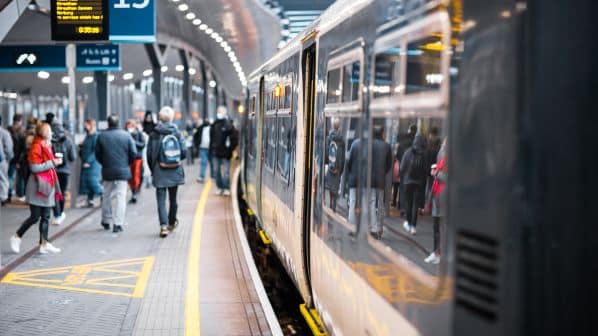THE 2700 delegates who gathered for the International Association of Public Transport’s (UITP) Global Public Transport Summit in Barcelona last month heard of the various challenges that have impacted the sector since the Covid-19 pandemic.
Chief among them is the change in travelling habits of urban rail passengers. Gone are the days of two distinct weekday peaks where passengers would pack onto trains and travel to their place of work in the morning and do so again to return home at the end of the day. We are living in a new normal where demand is more evenly spread, and where more people than before are using the train for purposes other than commuting.
Crucially, this new paradigm requires a fresh approach to how operators engage with and serve their customers. There is a growing emphasis on enticing a broader range of passengers onto rail to make up for the shortfall in commuters, many of whom may have been overlooked in the past.
The summit’s programme reflected this appetite. There were sessions dedicated to improving accessibility for disabled passengers across the public transport network; enhancing the environment and improving safety for female passengers, who make up over half of the public transport users; engaging with non-digital natives; and making stations generally safer, better connected and more welcoming places to be.
These improvements cannot come soon enough. Unfortunately, the experience of using public transport is all too often very different to the utopian vision presented at industry events. Indeed, there was a sense of frustration in Barcelona at why many of the ideas and concepts presented, some of which have been around for years, are not already more widely deployed.
For example, universal ticketing remains frustratingly out of reach. Despite the success of ticketing based on contactless bank cards in some cities, too many still use systems that are confusing. Visitors may be forced to wait in a long queue to buy a paper ticket from an unfamiliar machine, which might not accept their foreign bank or credit card. Station wayfinding can also be difficult for new users of a network.
As Neil Bates of Creactive argues, the industry has largely failed to grasp the importance of the passenger experience, which should be at the centre of how trains, stations and other public transport amenities are designed. People should want to use a train, which the train builder is able to manufacture, and the railway wants to operate and maintain.
Taking this approach could also open up new opportunities not previously foreseen. For example, amenities such as a reliable onboard Wi-Fi connection could support the offer of additional services to passengers, boosting ancillary revenue. More of this kind of creative thinking is required for success in the new normal.
The cost of public transport remains a real factor in whether passengers will use the train or not. Ms Stephanie Wiggins, CEO of Los Angeles Metro, revealed how the operator has kept its base fare at $US 1.75 per journey post-pandemic to ensure it remains attractive. Metro has also instituted a range of ticketing initiatives aimed at offering discounted or free fares to low-income passengers and school and college students to boost ridership among these groups.
Unfortunately, the experience of using rail and public transport is all too often very different to the utopian vision presented at industry events.
Other initiatives presented during the session included the €49 Deutschland Ticket and Spain’s free regional ticketing initiative, both of which have been introduced following the pandemic as a means of encouraging people to use rail over other modes.
These programmes have proven extremely popular with passengers - Mr Till Ackerman of the German Public Transport Association (VDV), revealed that 10 million Deutschland Tickets have been sold in the first month since sales opened, with 7% of these purchased by new customers. He expects 15-16 million of the all-Germany regional monthly season tickets to be sold by the end of this year.
Governments have had to find billions to cover the cost of these programmes and the debate over who ultimately pays dominated much of the discussion during a session on the morning of June 5.
French MEP, Ms Karima Delli, made an impassioned case for free public transport, arguing that the climate crisis demands a rapid change in transport use and that governments should be ready to meet these costs. She was countered by Mr Brieuc de Meeûs, CEO of Brussels public transport operator Stib, who pointed out that farebox revenue is crucial to fund continuing operations and maintenance, especially at a time when staff wages and essential costs have risen, due in no small part to the European energy crisis.
Wiggins pointed out that Los Angeles Metro is in the envious position of receiving 2% of all sales tax revenue generated in the city, a measure approved by voters. Much of this funding is channelled towards capital projects - Los Angeles has the United States’ largest planned public transport expansion programme. Yet having this assurance in place provides the operator with the flexibility to invest in its free ticketing programmes.
Free ticketing is credited with helping to improve attendance at schools across Los Angeles, emphasising the wider societal benefits provided by an effective public transport network. This outcome is also consistent with the message of Professor Mariana Mazzucato’s keynote speech at the opening of the summit. Mazzucato argued that societal targets should be at the heart of an innovation agenda that aligns the objectives of the public and private sectors to deliver a green and more prosperous city. By offering emission-free connectivity that supports economic development, an effective public transport network is a key driver of this objective.
Ultimately it is up to the sector to make the case that it is ready to play this role. An operating environment which is attractive and where no passenger is truly left behind will make this argument far easier to make.

